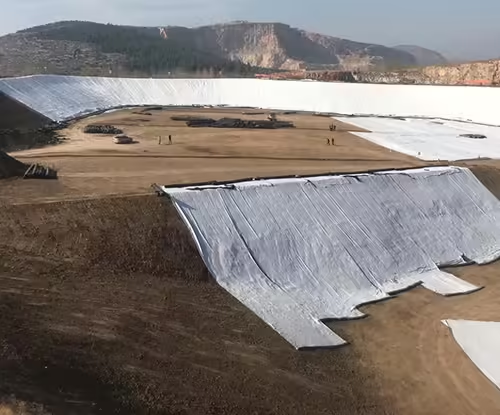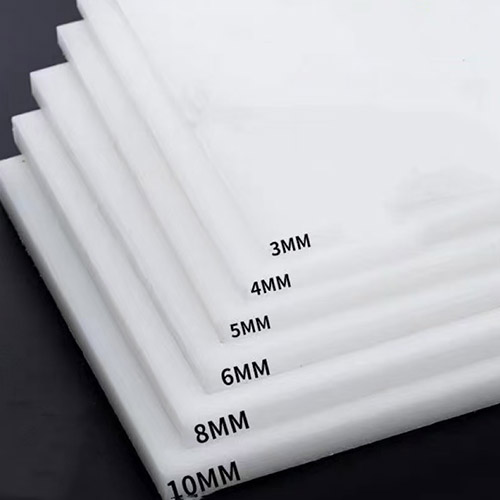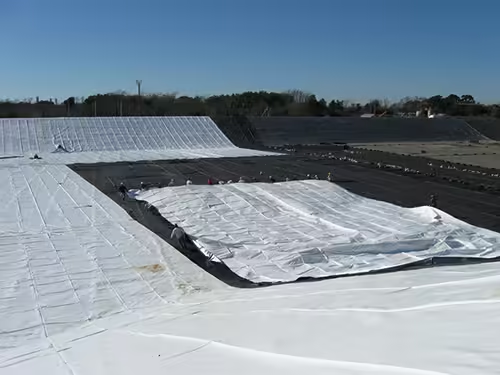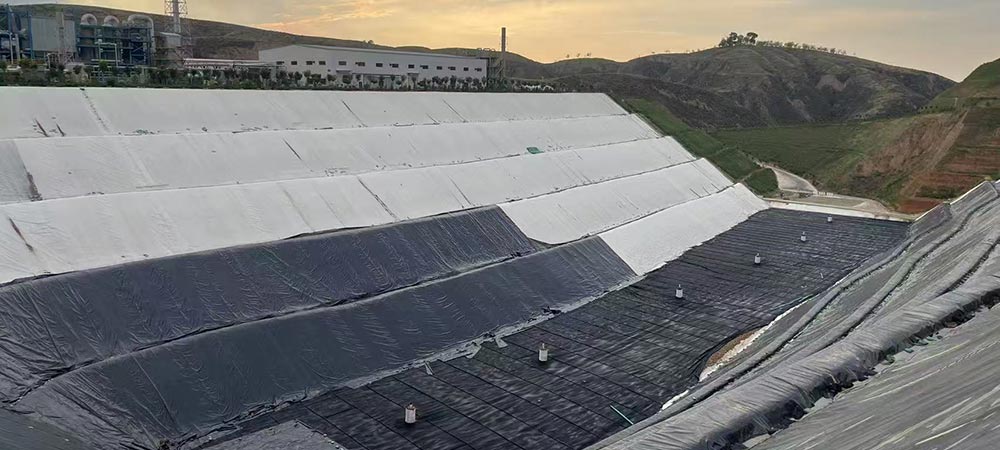
Welcome to My Blog!
Before we dive into the content, I’d love for you to join me on my social media platforms where I share more insights, engage with the community, and post updates. Here’s how you can connect with me:
Facebook:https://www.facebook.com/profile.php?id=61576267991871
Now, let’s get started on our journey together. I hope you find the content here insightful, engaging, and valuable.
Table of Contents
Introduction
In today’s environmentally conscious world, geosynthetic liners are crucial for protecting our natural resources. These “unsung heroes” create invisible barriers that safeguard ecosystems and prevent contamination, from water purity to hazardous waste containment.
At EcoGeo Material, a professional geosynthetic factory in Shandong, China, we specialize in high-quality geomembranes and other geosynthetic materials. We provide robust solutions that revolutionize environmental protection in water management, waste containment, and landscape restoration. Join us to discover how these advanced materials build a more sustainable future.
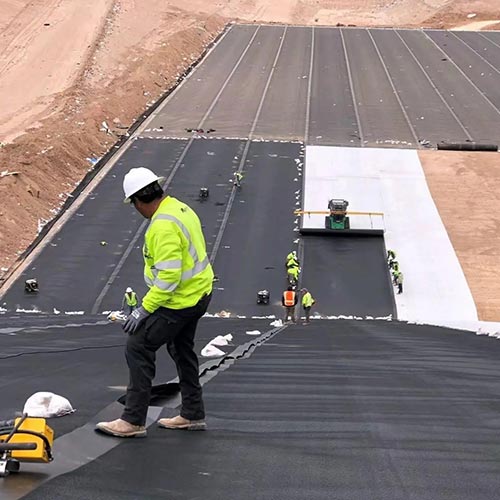
The Imperative of Environmental Protection
Our planet faces unprecedented environmental pressures, driven by industrialization, population growth, and evolving consumption patterns. The consequences are far-reaching: water scarcity, soil degradation, air pollution, and the accumulation of waste that threatens both human health and ecological balance. Traditional methods of containment and remediation often fall short, struggling to provide the long-term, impermeable barriers necessary for effective environmental stewardship. This is where advanced engineering solutions become not just beneficial, but absolutely essential. The demand for reliable, durable, and cost-effective materials that can prevent leakage, control erosion, and support sustainable infrastructure is greater than ever.
What Exactly Are Geosynthetic Liners?
Geosynthetic liners are specialized polymeric materials, typically in sheet form, designed to act as impermeable barriers within various engineering projects. While the term often brings to mind the large, black sheets used in landfills, the family of geosynthetic liners is diverse, encompassing various materials and formulations, each tailored for specific performance requirements.
Composition and Types of Geosynthetic Liners
These liners are primarily made from synthetic polymers such as high-density polyethylene (HDPE), low-density polyethylene (LDPE), very low-density polyethylene (VLDPE), and polypropylene (PP). Each polymer offers distinct characteristics in terms of flexibility, chemical resistance, UV stability, and puncture resistance.
- HDPE Geomembranes: Known for their excellent chemical resistance, high strength, and durability, HDPE geomembranes are widely used in demanding applications like hazardous waste landfills and mining containment ponds. Their rigidity makes them ideal for large, relatively flat areas.
- LDPE Geomembranes: Offering greater flexibility than HDPE, LDPE geomembranes are often preferred for applications requiring conformity to irregular surfaces, such as decorative ponds or smaller containment areas.
- VLDPE Geomembranes: Providing even greater flexibility and elongation properties, VLDPE geomembranes are suitable for projects where significant differential settlement is expected.
- PP Geomembranes: Polypropylene liners are valued for their broad chemical resistance and suitability for high-temperature applications.
The selection of the appropriate geosynthetic liner depends on the specific project’s requirements, including the type of fluid to be contained, anticipated stresses, environmental conditions, and regulatory compliance.
How Geosynthetic Liners Protect Our Environment
The environmental benefits of geosynthetic liners are vast and multifaceted. They serve as critical components in preventing pollution, conserving resources, and supporting sustainable development.
Preventing Contamination
One of the primary functions of a geosynthetic liner is to act as an impermeable barrier. This is crucial in preventing the migration of pollutants from contained areas into surrounding soil and groundwater.
- Landfills: In modern landfills, geosynthetic liners form the base and cap systems, preventing leachate (the liquid that seeps through waste) from contaminating underlying aquifers and surface water bodies. This is arguably one of the most vital applications for geosynthetic liners in environmental protection.
- Mining: Tailings ponds and heap leach pads in mining operations utilize geosynthetic liners to contain highly acidic or alkaline process solutions, preventing their escape into the environment.
- Industrial Containment: Chemical storage facilities, industrial wastewater ponds, and secondary containment areas for fuel tanks all rely on geosynthetic liners to guard against spills and leaks.
Water Resource Management
Geosynthetic liners play a significant role in managing and conserving water resources, especially in regions facing water scarcity.
- Reservoirs and Ponds: Lining reservoirs, irrigation canals, and aquaculture ponds with geosynthetic liners prevents water loss through seepage, ensuring more efficient water utilization for agriculture, drinking water supply, and recreational purposes.
- Wastewater Treatment: In wastewater treatment plants, geosynthetic liners are used in aeration ponds and sludge lagoons to prevent the leakage of treated or partially treated wastewater into the ground.
Erosion Control and Soil Stabilization
While geomembranes primarily serve as barriers, other geosynthetic materials, often used in conjunction with liners, contribute to erosion control and soil stabilization, indirectly protecting environmental integrity. Geotextiles, for instance, can separate soil layers, reinforce unstable ground, and filter water, reducing soil erosion and maintaining landscape stability.
Enhancing Remediation Efforts
Geosynthetic liners are also integral to environmental remediation projects, facilitating the cleanup of contaminated sites. They can be used as part of cap-and-containment systems for contaminated soils, isolating pollutants and preventing their further spread. This allows for the gradual remediation of the site without ongoing environmental release.
Applications Across Industries
The versatility of geosynthetic liners makes them indispensable across a wide range of industries and environmental challenges. From large-scale infrastructure projects to specialized containment needs, their application scope continues to expand.
| Application Area | Purpose of Geosynthetic Liner | Key Environmental Benefit |
| Water Conservancy | Prevents seepage in reservoirs, canals, and dams | Water conservation, prevents groundwater contamination |
| Environmental Protection | Liners for landfills, wastewater ponds, and industrial containment | Prevents pollution of soil and water, safe waste management |
| Municipal Engineering | Basement waterproofing, underground utility protection, storm ponds | Protects infrastructure from water damage, controls runoff |
| Aquaculture | Lining fish and shrimp ponds | Prevents water loss, maintains water quality, disease control |
| Sewage Treatment | Lining aeration basins and sludge drying beds | Prevents leakage of contaminants, ensures treatment efficiency |
| Tailings Anti-seepage | Contains mining waste and process solutions | Prevents heavy metal and chemical pollution |
| Landfill | Base liners and final caps | Prevents leachate migration, minimizes environmental impact |
| Landscape Engineering | Lining artificial lakes, golf course ponds, and green roofs | Water retention, aesthetic value, storm water management |
| Slope Greening | Erosion control, root barrier in conjunction with other geosynthetics | Prevents soil erosion, promotes vegetation growth |
| Mine Restoration | Capping contaminated areas, creating new containment | Isolates pollutants, facilitates site rehabilitation |
Advantages of Utilizing Geosynthetic Liners
Beyond their fundamental role in containment, geosynthetic liners offer several compelling advantages that contribute to their widespread adoption and environmental efficacy.
Durability and Longevity
Modern geosynthetic liners are engineered for exceptional durability. They are highly resistant to chemical attack, UV degradation, biological growth, and extreme temperatures. This ensures their effectiveness over extended periods, often designed for operational lives of many decades, minimizing the need for costly and environmentally disruptive replacements. This long lifespan contributes significantly to the overall sustainability of projects.
Cost-Effectiveness
While the initial investment in high-quality geosynthetic liners might seem substantial, their long-term cost-effectiveness is undeniable. They reduce the need for expensive natural clay liners (which are often less reliable), minimize excavation and material transportation, and significantly lower the risk of costly environmental remediation due due to leaks. The prevention of contamination itself represents an immeasurable cost saving in terms of environmental damage and potential fines.
Ease of Installation
Compared to traditional compacted clay liners, geosynthetic liners are relatively quick and easy to install. They are manufactured in large rolls, allowing for rapid deployment over vast areas. Welding techniques ensure strong, continuous seams, creating a monolithic barrier. This efficiency in installation translates to shorter project timelines and reduced labor costs.
Flexibility and Adaptability
Geosynthetic liners are incredibly versatile. Their flexibility allows them to conform to irregular ground surfaces, accommodate differential settlement, and be installed in a variety of challenging terrains. This adaptability makes them suitable for a diverse range of applications, from flat landfill bases to steep slope containment and intricate architectural water features.
Superior Barrier Performance
Ultimately, the most critical advantage of geosynthetic liners is their superior barrier performance. Unlike natural clay, which can crack due to desiccation or settlement, geosynthetic liners provide a near-absolute barrier to fluid migration. Their low permeability coefficients ensure that contaminants remain contained, providing reliable, long-term environmental protection.
The Role of Innovation and Quality
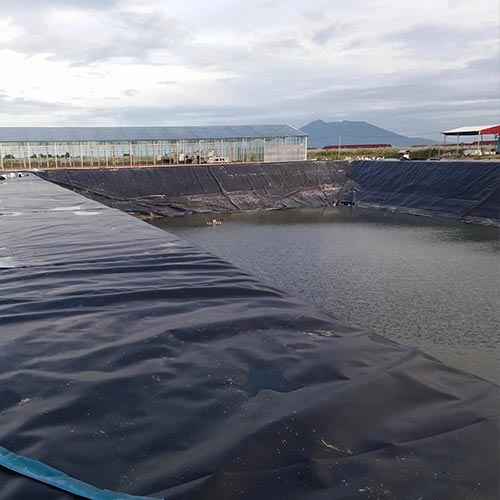

The effectiveness of geosynthetic liners hinges on the quality of their manufacturing and installation. Advances in polymer science and engineering continue to improve the performance characteristics of these materials, making them even more reliable and robust. Rigorous quality control during production, coupled with precise installation techniques, including comprehensive field testing of welds, are paramount to ensuring the integrity of the barrier system.
At EcoGeo Material, we pride ourselves on our commitment to innovation and quality. Our state-of-the-art facilities in Shandong Province are dedicated to the research, development, and production of top-tier geomembranes, geotextiles, and other geosynthetic materials. We understand that the environmental stakes are high, and we ensure our products meet the most stringent international standards for performance and durability, guaranteeing effective environmental protection for all our projects.
Conclusion
Geosynthetic liners are more than just construction materials; they are fundamental tools in our global effort to protect the environment. From preventing the pollution of precious water resources to safely containing hazardous waste and aiding in the restoration of damaged ecosystems, their role is indispensable. These precision-engineered barriers provide durable, cost-effective, and highly effective solutions that safeguard our natural heritage for generations to come. Their superior barrier performance, combined with their longevity and versatility, positions them as key components in sustainable infrastructure development worldwide.
As environmental challenges continue to mount, the demand for reliable and high-performance solutions like geosynthetic liners will only grow. By choosing high-quality geosynthetic liners, we are making a proactive investment in the health of our planet and the well-being of future generations. If your next project demands the highest standards of environmental protection and containment, look no further than EcoGeo Material. We are ready to provide the expertise and products you need to succeed. Contact us today to learn how our geosynthetic liner solutions can provide the robust environmental protection your project requires.
FAQ
What is the primary function of a geosynthetic liner?
The primary function of a geosynthetic liner is to act as an impermeable barrier, preventing the migration of liquids or gases from one area to another. This is crucial for environmental protection, preventing pollution of soil and water.
What types of materials are geosynthetic liners typically made from?
Geosynthetic liners are commonly made from polymers such as High-Density Polyethylene (HDPE), Low-Density Polyethylene (LDPE), Very Low-Density Polyethylene (VLDPE), and Polypropylene (PP), each chosen for specific project requirements.
Where are geosynthetic liners most commonly used for environmental protection?
They are widely used in landfills, mining operations (for tailings ponds), industrial containment facilities, wastewater treatment plants, and in water conservancy projects like reservoirs and canals.
Are geosynthetic liners environmentally friendly themselves?
While they are synthetic products, their environmental benefit comes from their ability to prevent much larger environmental harms like pollution of groundwater and soil. Their long lifespan also reduces the need for frequent replacement, contributing to sustainability.
How long do geosynthetic liners last?
High-quality geosynthetic liners are designed for exceptional durability and can last for many decades, often exceeding 50 years, depending on the specific material, installation quality, and environmental conditions.


